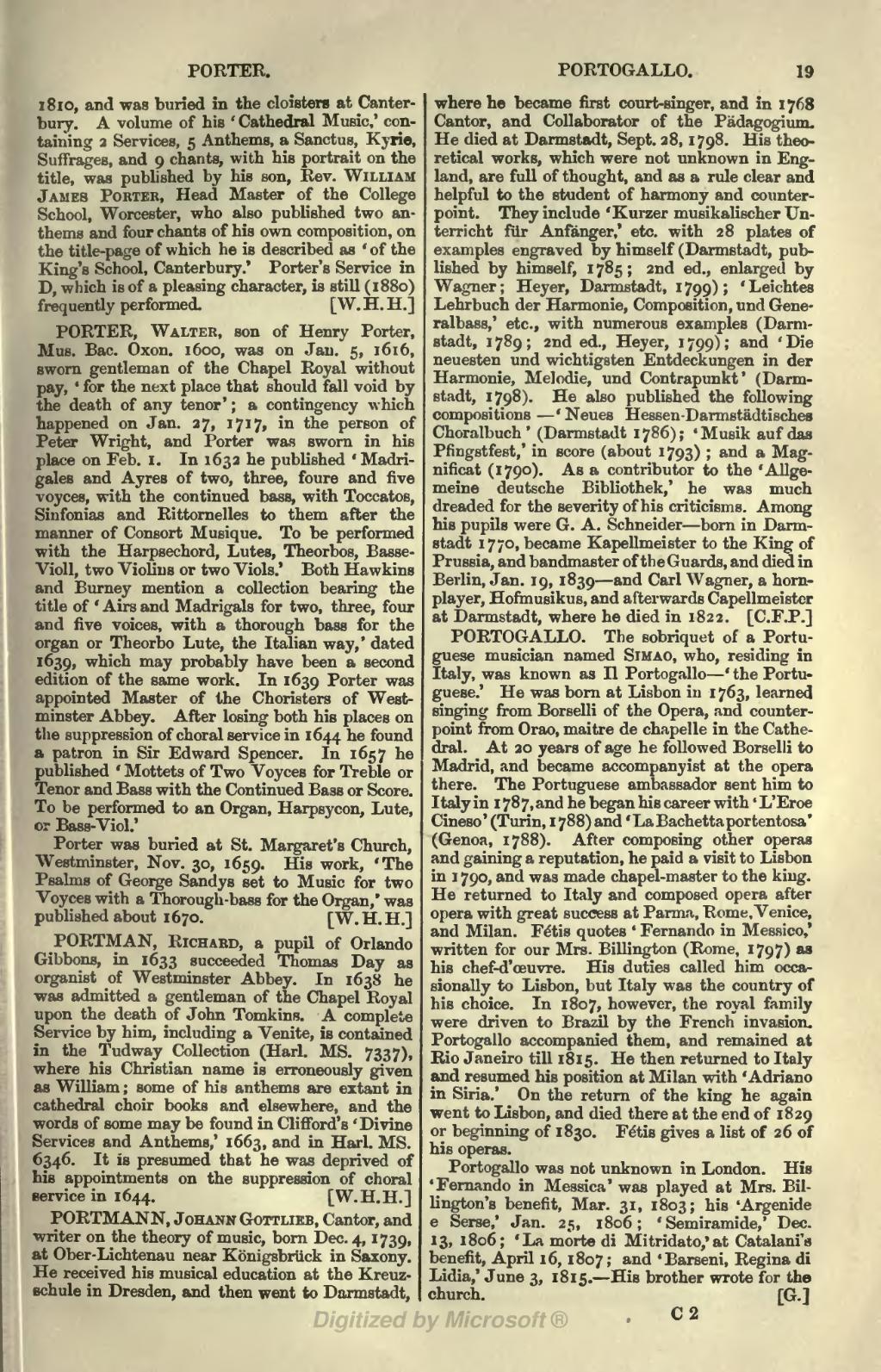1810, and was buried in the cloisters at Canterbury. A volume of his 'Cathedral Music,' containing 2 Services, 5 Anthems, a Sanctus, Kyrie, Suffrages, and 9 chants, with his portrait on the title, was published by his son, Rev. William james Porter, Head Master of the College School, Worcester, who also published two anthems and four chants of his own composition, on the title-page of which he is described as 'of the King's School, Canterbury.' Porter's Service in D, which is of a pleasing character, is still (1880) frequently performed.
[ W. H. H. ]
PORTER, Walter, son of Henry Porter, Mus. Bac. Oxon. 1600, was on Jan. 5, 1616, sworn gentleman of the Chapel Royal without pay, 'for the next place that should fall void by the death of any tenor'; a contingency which happened on Jan. 27, 1717, in the person of Peter Wright, and Porter was sworn in his place on Feb. 1. In 1632 he published 'Madrigales and Ayres of two, three, foure and five voyces, with the continued bass, with Toccatos, Sinfonias and Rittornelles to them after the manner of Consort Musique. To be performed with the Harpsechord, Lutes, Theorbos, Basse-Violl, two Violins or two Viols.' Both Hawkins and Burney mention a collection bearing the title of 'Airs and Madrigals for two, three, four and five voices, with a thorough bass for the organ or Theorbo Lute, the Italian way,' dated 1639, which may probably have been a second edition of the same work. In 1639 Porter was appointed Master of the Choristers of Westminster Abbey. After losing both his places on the suppression of choral service in 1644 he found a patron in Sir Edward Spencer. In 1657 he published 'Mottets of Two Voyces for Treble or Tenor and Bass with the Continued Bass or Score. To be performed to an Organ, Harpsycon, Lute, or Bass-Viol.'
Porter was buried at St. Margaret's Church, Westminster, Nov. 30, 1659. His work, 'The Psalms of George Sandys set to Music for two Voyces with a Thorough-bass for the Organ,' was published about 1670.
[ W. H. H. ]
PORTMAN, Richard, a pupil of Orlando Gibbons, in 1633 succeeded Thomas Day as organist of Westminster Abbey. In 1638 he was admitted a gentleman of the Chapel Royal upon the death of John Tomkins. A complete Service by him, including a Venite, is contained in the Tudway Collection (Harl. MS. 7337), where his Christian name is erroneously given as William; some of his anthems are extant in cathedral choir books and elsewhere, and the words of some may be found in Clifford's 'Divine Services and Anthems,' 1663, and in Harl. MS. 6346. It is presumed that he was deprived of his appointments on the suppression of choral service in 1644.
[ W. H. H. ]
PORTMANN, Johann Gottlieb, Cantor, and writer on the theory of music, born Dec. 4, 1739, at Ober-Lichtenau near Königsbrück in Saxony. He received his musical education at the Kreuzschule in Dresden, and then went to Darmstadt, where he became first court-singer, and in 1768 Cantor, and Collaborator of the Pädagogium. He died at Darmstadt, Sept. 28, 1798. His theoretical works, which were not unknown in England, are full of thought, and as a rule clear and helpful to the student of harmony and counterpoint. They include 'Kurzer musikalischer Unterricht für Anfänger,' etc. with 28 plates of examples engraved by himself (Darmstadt, published by himself, 1785; 2nd ed., enlarged by Wagner; Heyer, Darmstadt, 1799); 'Leichtes Lehrbuch der Harmonie, Composition, und Generalbass,' etc., with numerous examples (Darmstadt, 1789; 2nd ed., Heyer, 1799); and 'Die neuesten und wichtigsten Entdeckungen in der Harmonie, Melodie, und Contrapunkt' (Darmstadt, 1798). He also published the following compositions—'Neues Hessen-Darmstädtisches Choralbuch' (Darmstadt 1786); 'Musik auf das Pfingstfest,' in score (about 1793); and a Magnificat (1790). As a contributor to the 'Allgemeine deutsche Bibliothek,' he was much dreaded for the severity of his criticisms. Among his pupils were G. A. Schneider—born in Darmstadt 1770, became Kapellmeister to the King of Prussia, and bandmaster of the Guards, and died in Berlin, Jan. 19, 1839—and Carl Wagner, a horn-player, Hofmusikus, and afterwards Capellmeister at Darmstadt, where he died in 1822.
[ C. F. P. ]
PORTOGALLO. The sobriquet of a Portuguese musician named Simao [App. p.751 "add Christian name Marcantonio"], who, residing in Italy, was known as Il Portogallo—'the Portuguese.' He was born at Lisbon in 1763 [App. p.751 "March 24, 1762"] learned singing from Borselli of the Opera, and counterpoint from Orso, maître de chapelle in the Cathedral. At 20 years of age he followed Borselli to Madrid, and became accompanyist at the opera there. The Portuguese ambassador sent him to Italy in 1787, and he began his career with 'L'Eroe Cineso' (Turin, 1788) and 'La Bachetta portentosa' (Genoa, 1788). After composing other operas and gaining a reputation, he paid a visit to Lisbon in 1790, and was made chapel-master to the king. He returned to Italy and composed opera after opera with great success at Parma, Rome, Venice, and Milan. Fétis quotes 'Fernando in Messico,' written for our Mrs. Billington (Rome, 1797) as his chef-d'œuvre. His duties called him occasionally to Lisbon, but Italy was the country of his choice. In 1807, however, the royal family were driven to Brazil by the French invasion. Portogallo accompanied them, and remained at Rio Janeiro till 1815. He then returned to Italy and resumed his position at Milan with 'Adriano in Siria.' On the return of the king he again went to Lisbon, and died there at the end of 1829 or beginning of 1830 [App. p.751 "Feb 7, 1830"]. Fétis gives a list of 26 of his operas.
Portogallo was not unknown in London. His 'Fernando in Messica' was played at Mrs. Billington's benefit, Mar. 31, 1803; his 'Argenide e Serse,' Jan. 25, 1806; 'Semiramide,' Dec. 13, 1806; 'La morte di Mitridato,' at Catalani's benefit, April 16, 1807; and 'Barseni, Regina di Lidia,' June 3, 1815. His brother wrote for the church.
[ G. ]
